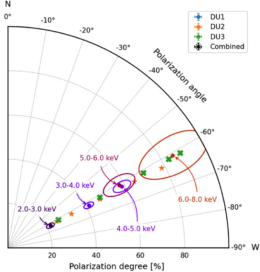Astronomers have observed polarised X-rays emitted by a magnetar, opening the door to understanding these extreme objects in more detail.
Magnetic Remnants

A magnetar is a sub-type of a stellar remnant called a neutron star. Magnetars and neutron stars are made solely of neutrons, and they are about 10–15 miles across. This illustration places a neutron star next to Manhattan for comparison. [NASA/Goddard Space Flight Center]
Their strong magnetic fields make magnetars prone to dramatic outbursts, emitting radiation across the electromagnetic spectrum. A magnetar’s X-ray bursts are particularly spectacular, with their X-ray flux suddenly leaping by a factor of up to a thousand.

An artist’s impression of the Imaging X-ray Polarimetry Explorer (IXPE) spacecraft. [NASA]
Focusing on Flares
It hasn’t always been clear, however, where these flares are coming from. They could spring from the crust of the magnetar itself, or they could launch from material trapped in an atmosphere around it. A team led by Silvia Zane (University College London) recently went looking for answers using the Imaging X-ray Polarimetry Explorer (IXPE). Launched at the end of 2021, it is a joint mission between NASA and the Italian Space Agency.
As its name suggests, IXPE observes the polarisation of X-rays. Light is polarised if its waves all vibrate in the same plane. Zane’s team used IXPE to observe the polarisation of the magnetar known as 1RXS J170849.0-40091 to see if they could work out what was corralling the X-rays.
Belts, Caps, and More

Polarisation of the magnetar in different energy bands. The colors of the circles represent different detector units (DUs), and the orange stars and green crosses show the predictions for the “belt plus cap” and “cap plus cap” models, respectively. [Adapted from Zane et al. 2023]
The team ran simulations of various magnetar configurations to see if they could explain this result, settling on two possibilities. The first, which they call “belt plus cap,” has a warm region around the magnetar’s equator and a hotter atmosphere confined to a circular polar cap. The second, called “cap plus cap,” has the X-ray emission emanating from two circular spots. One is on the surface of the magnetar, and there’s a hotter atmospheric spot located in the opposite hemisphere.
Further work to untangle these two possibilities could have wider implications. Astronomers have previously suggested that magnetars are the main source of fast radio bursts, for example. Understanding why magnetars flare could help cement this link and assist astronomers in explaining these mysterious events.
Citation
“A Strong X-Ray Polarization Signal from the Magnetar 1RXS J170849.0-400910,” Silvia Zane et al 2023 ApJL 944 L27. doi:10.3847/2041-8213/acb703

